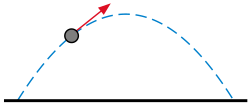Boundary Value Problems/Ordinary-Differential-Equations
In mathematics, an ordinary differential equation (or ODE) is a relation that contains functions of only one independent variable, and one or more of its derivatives with respect to that variable.
A simple example is Newton's second law of motion, which leads to the differential equation
for the motion of a particle of constant mass m. In general, the force F depends upon the position of the particle x(t) at time t, and thus the unknown function x(t) appears on both sides of the differential equation, as is indicated in the notation F(x(t)).
Ordinary differential equations are distinguished from partial differential equations, which involve partial derivatives of several variables.
Ordinary differential equations arise in many different contexts including geometry, mechanics, astronomy and population modelling. Many famous mathematicians have studied differential equations and contributed to the field, including Isaac Newton|Newton, Leibniz, the Bernoulli family, Riccati, Alexis Claude Clairaut, d'Alembert and Euler.
Much study has been devoted to the solution of ordinary differential equations. In the case where the equation is linear, it can be solved by analytical methods. Unfortunately, most of the interesting differential equations are non-linear and, with a few exceptions, cannot be solved exactly. Approximate solutions are arrived at using computer approximations (see numerical ordinary differential equations).

Ordinary differential equation
[edit | edit source]Let y be an unknown function
in x with the nth derivative of y, then an equation of the form
is called an ordinary differential equation (ODE) of order n; for vector valued functions,
- ,
it is called a system of ordinary differential equations of dimension m.
When a differential equation of order n has the form
it is called an implicit differential equation whereas the form
is called an explicit differential equation.
A differential equation not depending on x is called autonomous.
A differential equation is said to be linear if F can be written as a linear combination of the derivatives of y
with ai(x) and r(x) continuous functions in x. The function r(x) is called the source term; if r(x)=0 then the linear differential equation is called homogeneous, otherwise it is called non-homogeneous or inhomogeneous.
Solutions
[edit | edit source]Given a differential equation
a function u: I ⊂ R → R, is called the solution or integral curve for F, if u is n-times differentiable on I, and
Given two solutions u: J ⊂ R → R and |v: I ⊂ R → R, u is called an extension of v ifI ⊂ J and
A solution which has no extension is called a global solution.
A general solution of an n-th order equation is a solution containing n arbitrary variables, corresponding to n constant of integration|constants of integration. A particular solution is derived from the general solution by setting the constants to particular values, often chosen to fulfill set 'initial value problem|initial conditions or boundary conditions. A singular solution is a solution that can't be derived from the general solution.
Reduction to a first order system
[edit | edit source]Any differential equation of order n can be written as a system of n first-order differential equations. Given an explicit ordinary differential equation of order n and dimension 1,
we define a new family of unknown functions
We can then rewrite the original differential equation as a system of differential equations with order 1 and dimension n.
which can be written concisely in vector notation as
with
Linear ordinary differential equations
[edit | edit source]A well understood particular class of differential equations is linear differential equations. We can always reduce an explicit linear differential equation of any order to a system of differential equation of order 1
which we can write concisely using matrix and vector notation as
with
Homogeneous equations
[edit | edit source]The set of solutions for a system of homogeneous linear differential equations of order 1 and dimension n
forms an n-dimensional vector space. Given a basis for this vector space , which is called a fundamental system, every solution can be written as
The n × n matrix
is called fundamental matrix. In general there is no method to explicitly construct a fundamental system, but if one solution is known d'Alembert reduction can be used to reduce the dimension of the differential equation by one.
Nonhomogeneous equations
[edit | edit source]The set of solutions for a system of inhomogeneous linear differential equations of order 1 and dimension n
can be constructed by finding the fundamental system to the corresponding homogeneous equation and one particular solution to the inhomogeneous equation. Every solution to nonhomogeneous equation can then be written as
A particular solution to the nonhomogeneous equation can be found by the method of undetermined coefficients or the method of variation of parameters.
Fundamental systems for homogeneous equations with constant coefficients
[edit | edit source]If a system of homogeneous linear differential equations has constant coefficients
then we can explicitly construct a fundamental system. The fundamental system can be written as a matrix differential equation
with solution as a matrix exponential
which is a fundamental matrix for the original differential equation. To explicitly calculate this expression we first transform A into Jordan normal form
and then evaluate the Jordan blocks
of J separately as
Bibliography
[edit | edit source]- A. D. Polyanin and V. F. Zaitsev, Handbook of Exact Solutions for Ordinary Differential Equations (2nd edition), Chapman & Hall/CRC Press, Boca Raton, 2003. ISBN 1-58488-297-2
- A. D. Polyanin, V. F. Zaitsev, and A. Moussiaux, Handbook of First Order Partial Differential Equations, Taylor & Francis, London, 2002. ISBN 0-415-27267-X
- D. Zwillinger, Handbook of Differential Equations (3rd edition), Academic Press, Boston, 1997.
- Hartman, Philip, Ordinary Differential Equations, 2nd Ed., Society for Industrial & Applied Math, 2002. ISBN 0-89871-510-5.
- W. Johnson, A Treatise on Ordinary and Partial Differential Equations, John Wiley and Sons, 1913, in University of Michigan Historical Math Collection
- E.L. Ince, Ordinary Differential Equations, Dover Publications, 1958, ISBN 0486603490
- Witold Hurewicz Lectures on Ordinary Differential Equations, Dover Publications, ISBN 0-486-49510-8





































